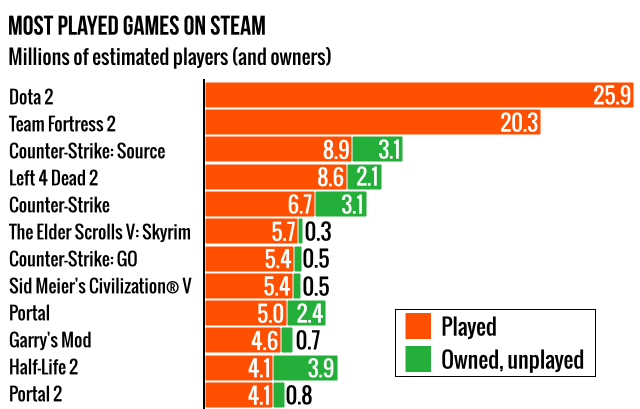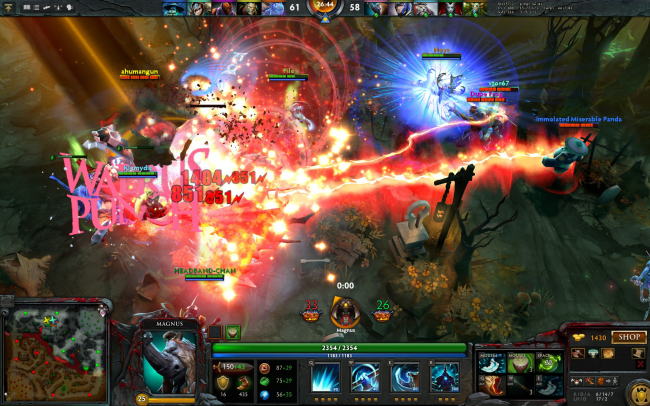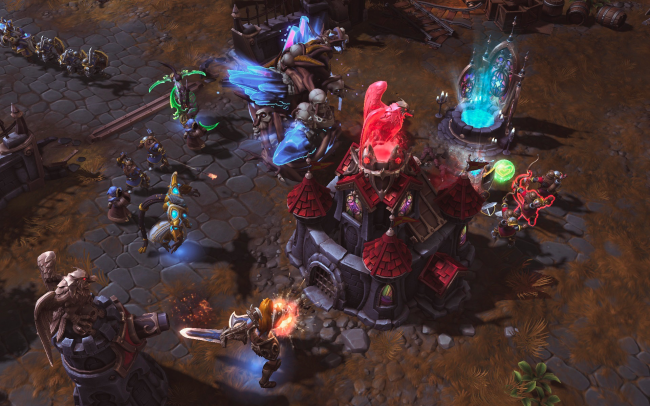- Wondering how to get Monopoly GO! free rolls? Well, you’ve come to the right place. In this guide, we provide you with a bunch of tips and tricks to get some free rolls for the hit new mobile game. We’ll …
Best Roblox Horror Games to Play Right Now – Updated Weekly
By Adele Wilson
Our Best Roblox Horror Games guide features the scariest and most creative experiences to play right now on the platform!The BEST Roblox Games of The Week – Games You Need To Play!
By Sho Roberts
Our feature shares our pick for the Best Roblox Games of the week! With our feature, we guarantee you'll find something new to play!All Grades in Type Soul – Each Race Explained
By Adele Wilson
Our All Grades in Type Soul guide lists every grade in the game for all races, including how to increase your grade quickly!
Steam user data reveals the best way to do Free-To-Play
If you want an intense and fantastic example of Real Games Journalism, I recommend checking out Kyle Orland’s exhaustive analysis of Steam user data at Ars Technica. It shows some incredibly interesting trends on how Steam users are buying — and playing — their games.
What I’m most interested in is what this means for free-to-play games and development in general. The top two games on Steam right now — both in terms of total users and hours played — are free-to-play. Dota 2 and Team Fortress 2 both cost nothing to play, are essentially multiplayer-only, and started out as paid games. (In the case of Dota 2, that payment was to get into the closed beta.)
Ignoring Team Fortress 2 for a moment, I think Dota 2 is particularly interesting. About four thousand human years have been put into the game since it hit beta in 2011. My Steam profile says I account for nearly 400 hours of that, so I can hardly feign surprise.

Steam is estimated to account for three-fourths of the PC gaming market so it’s not surprising that a game by Valve, the service’s creator, would have a top spot in downloads. Dota 2 gets understandably preferential treatment on Steam’s front page just about daily. It’s not surprising that a Valve game, according to Ars’ statistics, makes up a fifth of total playtime on a Valve service.

If you want an intense and fantastic example of Real Games Journalism, I recommend checking out Kyle Orland’s exhaustive analysis of Steam user data at Ars Technica. It shows some incredibly interesting trends on how Steam users are buying — and playing — their games.
What I’m most interested in is what this means for free-to-play games and development in general. The top two games on Steam right now — both in terms of total users and hours played — are free-to-play. Dota 2 and Team Fortress 2 both cost nothing to play, are essentially multiplayer-only, and started out as paid games. (In the case of Dota 2, that payment was to get into the closed beta.)
Ignoring Team Fortress 2 for a moment, I think Dota 2 is particularly interesting. About four thousand human years have been put into the game since it hit beta in 2011. My Steam profile says I account for nearly 400 hours of that, so I can hardly feign surprise.

Ars Technica’s deep-dive on Steam stats in incredible. Read it.
Steam is estimated to account for three-fourths of the PC gaming market so it’s not surprising that a game by Valve, the service’s creator, would have a top spot in downloads. Dota 2 gets understandably preferential treatment on Steam’s front page just about daily. It’s not surprising that a Valve game, according to Ars’ statistics, makes up a fifth of total playtime on a Valve service.
It’s also free-to-play, which reduces the biggest barrier to entry beyond user bandwidth. We saw this concept proved out with Free To Play (the Dota 2 “documentary” from Valve). As of March 24 the film about eSports professionals had been watched 5.5 million times. That’s a staggering number until you realize that it’s free to own and watch.
The low-walled garden would account for total downloads, but hardly hours played. The latter is more than two times the total of the number two game, Team Fortress 2. In my experience, people are playing because it’s a fantastic game and infinitely replayable.
That’s just good design, to an extent, but it’s also a good use of the free-to-play model — perhaps the best use.

This is the least crazy screenshot we could find of Dota 2. Honest. (via Steam Community’s Cyborgmatt)
Team Fortress 2 and Dota 2 both started as paid games that went free later on. As such they were built from the ground up to be good games first and largely succeeded. When the time came to make them free, players had already grown accustomed to a certain level of content. Instead of strip that away and make payers pay for it piecemeal, Valve added content to the games in the form of cosmetic options.
Dota 2 has hundreds if not thousands of aesthetic choices across its more than a hundred playable heroes, while Team Fortress 2 has its famous/infamous hats system. Being an isometric game, Dota 2 has a leg up on its first-person competitor in this regard, as not only can enemy players see your groovy kit, but you can, too.
Other free-to-play games, your Farmvilles and your Dungeon Keepers, seem concerned with money first and focus on fun after the fact. It happened with MMOs (who doesn’t love the idea of getting paid for the same product every month?), and that philosophy has migrated to microtransactions.
As such, we see such free-to-play games (and honestly, this can be applied to just about any triple-A publisher fad: music games, military shooters, etc.) move in fits and starts. Something is popular until it isn’t. Something new takes its place (or, in the case of the App Store, someone’s made-in-a-day clone moves up). Once people are sick of it, the EAs of the world move on to the next fad they can piggyback onto and try to exploit.

Activision/Blizzard preps their own MOBA: Heroes of the Storm
Not so with Steam’s most popular duo, it seems. Thousands of cumulative years spent on a single game over three years: that’s not a fad, that’s an institution unto itself. I’m sure EA and Activision would love to glom onto that trend as quickly as… Dawngate? Heroes of the Storm? Oh, I see. They already are.
There are likely more interesting trends to glean out of Orland’s data that I’m sure will crop up over time. For now, what I see is that publishers areright. Free-to-play does draws a crowd, to be certain. But that crowd is much more likely to stick around if you make a great game and sell it in a fair, intelligent way.
Diabolical economic scheming does not get you to four thousand years and counting.
More articles...
Monopoly GO! Free Rolls – Links For Free Dice
By Glen Fox
Wondering how to get Monopoly GO! free rolls? Well, you’ve come to the right place. In this guide, we provide you with a bunch of tips and tricks to get some free rolls for the hit new mobile game. We’ll …Best Roblox Horror Games to Play Right Now – Updated Weekly
By Adele Wilson
Our Best Roblox Horror Games guide features the scariest and most creative experiences to play right now on the platform!The BEST Roblox Games of The Week – Games You Need To Play!
By Sho Roberts
Our feature shares our pick for the Best Roblox Games of the week! With our feature, we guarantee you'll find something new to play!All Grades in Type Soul – Each Race Explained
By Adele Wilson
Our All Grades in Type Soul guide lists every grade in the game for all races, including how to increase your grade quickly!







